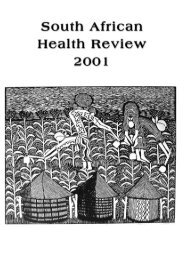The Status of Clinic Committees in Primary Level - Health Systems ...
The Status of Clinic Committees in Primary Level - Health Systems ...
The Status of Clinic Committees in Primary Level - Health Systems ...
Create successful ePaper yourself
Turn your PDF publications into a flip-book with our unique Google optimized e-Paper software.
with economic recession thereby plac<strong>in</strong>g an even greater stra<strong>in</strong> on already overstretched resources particularly<br />
<strong>in</strong> a develop<strong>in</strong>g country context. In their study <strong>of</strong> District <strong>Health</strong> Boards (DHBs) Macwan’gi and Ngwengwe<br />
(2004) also po<strong>in</strong>t out that the capacity <strong>of</strong> such entities to perform their functions was constra<strong>in</strong>ed by <strong>in</strong>adequate<br />
resources. <strong>The</strong> WHO study (1991) reports that community participation flourishes <strong>in</strong> socio-economic conditions<br />
which are conducive to development. <strong>The</strong>se <strong>in</strong>clude adequate staff, logistics and other resources which may be<br />
difficult to secure <strong>in</strong> a resource poor country. <strong>The</strong> impact <strong>of</strong> poor socio-economic conditions on the function<strong>in</strong>g<br />
<strong>of</strong> governance structures has also been noted by Boulle <strong>in</strong> her study <strong>of</strong> community health committees <strong>in</strong> the<br />
Nelson Mandela Bay Municipality where she found that there were <strong>in</strong>sufficient resources allocated to provide<br />
the necessary support to community health centres leav<strong>in</strong>g community participation a “neglected component<br />
<strong>of</strong> the health system” (Boulle, 2007: 62).<br />
Traditionally, the voluntary nature <strong>of</strong> serv<strong>in</strong>g on governance structures can affect the long term susta<strong>in</strong>ability<br />
<strong>of</strong> these structures. This can have negative effects particularly <strong>in</strong> contexts <strong>of</strong> high poverty and unemployment,<br />
where serv<strong>in</strong>g on governance structures can be seen as a means <strong>of</strong> generat<strong>in</strong>g <strong>in</strong>come. In South Africa, for<br />
example, <strong>Health</strong> <strong>Systems</strong> Trust (HST) found that cl<strong>in</strong>ic committee members felt aggrieved that members <strong>of</strong><br />
hospital boards received stipends, while they did not. <strong>Cl<strong>in</strong>ic</strong> committee members expressed <strong>in</strong>terest <strong>in</strong> f<strong>in</strong>d<strong>in</strong>g<br />
routes to be<strong>in</strong>g appo<strong>in</strong>ted on hospital boards as this was seen as a more lucrative and prestigious appo<strong>in</strong>tment<br />
than serv<strong>in</strong>g on a cl<strong>in</strong>ic committee (HST, 2007). In a similar ve<strong>in</strong>, but <strong>in</strong> a different economic context, the South<br />
Australian <strong>Health</strong> Department has acknowledged that community participation through governance structures<br />
is essential <strong>in</strong> improv<strong>in</strong>g and provid<strong>in</strong>g health services. However, they also caution that the voluntary nature<br />
<strong>of</strong> the local health boards is not susta<strong>in</strong>able due to the added pressures with which these local health boards<br />
have to deal. Accord<strong>in</strong>g to an Australian study “there are ever <strong>in</strong>creas<strong>in</strong>g pressures and demands that mean<br />
that exist<strong>in</strong>g volunteer structures are stretched, <strong>in</strong> some cases, beyond their capacity” (County <strong>Health</strong> – South<br />
Australia, 2006:1).<br />
2.7.3 <strong>The</strong> capacity <strong>of</strong> communities to participate <strong>in</strong> health services and adequate<br />
tra<strong>in</strong><strong>in</strong>g for community members to enable participation<br />
Community members may be reluctant to participate <strong>in</strong> health services due to a perceived lack <strong>of</strong> skills,<br />
knowledge and confidence to engage with health facility staff.<br />
Local people have few opportunities to develop their formal skills <strong>in</strong> relation to participat<strong>in</strong>g <strong>in</strong> health development<br />
(Baum and Kahssay, 1999). Communities <strong>of</strong>ten lack the language, <strong>in</strong>formation, cohesion, organisational structures<br />
and capacities for effectively engag<strong>in</strong>g <strong>in</strong> these structures and can become disempowered and distrustful <strong>in</strong> the<br />
process (Loewenson, 2000b). Communities may also lack the necessary structures, be unfamiliar with medical<br />
terms and be apprehensive about engag<strong>in</strong>g <strong>in</strong> debate and dialogue with health pr<strong>of</strong>essionals. Programmes<br />
therefore, must be explicit about the mechanisms and methods that will be used to overcome these obstacles<br />
and should <strong>in</strong>clude community education and capacity build<strong>in</strong>g as a key component <strong>of</strong> budget<strong>in</strong>g and plann<strong>in</strong>g<br />
for health services (Grubb et al. 2003). Ngulube et al. (2004) found that some <strong>of</strong> the weaknesses <strong>in</strong> the<br />
performance <strong>of</strong> health centre committees (HCC) <strong>in</strong>cluded the fact that members had an <strong>in</strong>herent fear <strong>of</strong> talk<strong>in</strong>g<br />
to educated people, were unclear about their roles and lacked the resources to fulfill their responsibilities. This is<br />
borne out by work carried out by the HST <strong>in</strong> South Africa which showed that confusion and uncerta<strong>in</strong>ty around<br />
roles and responsibilities are potentially the most endur<strong>in</strong>g problems fac<strong>in</strong>g governance structures. Research<br />
showed that that power and authority which is perceived to rest with the health facility staff plays a strong role<br />
<strong>in</strong> constra<strong>in</strong><strong>in</strong>g the effectiveness and agency <strong>of</strong> governance structures. As a result, <strong>in</strong>appropriate power struggles<br />
and escalat<strong>in</strong>g tension between the two groups have evolved (HST, 2007).<br />
A failure on the part <strong>of</strong> the relevant health authority to tra<strong>in</strong> and build the capacity <strong>of</strong> community members can<br />
also lead to less than optimal community participation. <strong>The</strong>re is <strong>of</strong>ten a need for long term support and capacity<br />
build<strong>in</strong>g <strong>of</strong> community members elected onto governance structures. In Kenya, for example, researchers<br />
reported that it took up to two years for a basic understand<strong>in</strong>g <strong>of</strong> the district health system and appropriate<br />
support systems to be established (NPPHCN, 1996). In the Free State <strong>in</strong> South Africa, Baez and Barron (2006)<br />
18
















